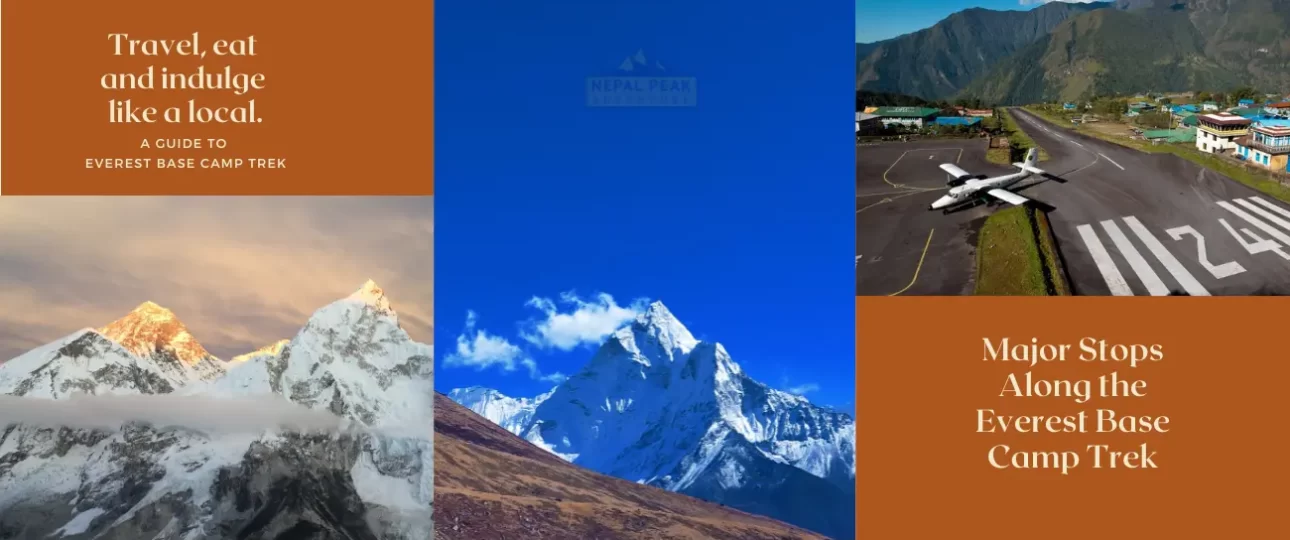Stops Along the Everest Base Camp Trek Route
The Everest Base Camp (EBC) trek is one of the most iconic trekking adventures in the world, offering breathtaking views of the highest mountain on Earth. The route is packed with incredible landscapes, cultural experiences, and, of course, essential rest stops that help you acclimatize and refuel during your journey.
In this blog, we’ll break down the major stops along the Everest Base Camp trek, as well as the lunch stops along the way, providing you with a detailed guide to planning your adventure.
Overview of the Everest Base Camp Route
The Everest Base Camp trek begins in the town of Lukla, a small settlement that has earned international fame due to its airport, which is considered one of the most dangerous in the world. From Lukla, trekkers follow a well-established path that winds through the Dudh Koshi Valley, passing through dense forests, crossing suspension bridges over rushing rivers, and weaving between small villages that are nestled into the Himalayan landscape.
The route follows a steady progression of altitude gain, and trekkers must be mindful of acclimatization to avoid altitude sickness. The journey from Lukla to Everest Base Camp typically takes between 12 and 14 days, depending on the pace and the number of acclimatization days taken. Key stops along the way, such as Namche Bazaar and Dingboche, allow trekkers to rest and acclimatize to the thinning air as they ascend higher into the mountains.
Major Overnight Stops on the EBC Trek
Lukla: The Gateway to Everest
Lukla (2,860 meters) is the official starting point of the Everest Base Camp trek. This town is the lifeline for the entire Khumbu region, serving as the main hub for trekkers, porters, guides, and supplies. The Lukla Airport, also known as Tenzing-Hillary Airport, is the most common entry point for trekkers heading to EBC. The flight into Lukla is nothing short of exhilarating, offering stunning aerial views of the mountains as well as the excitement of landing on a short runway nestled between the hills.
Lukla itself offers several trekking lodges, restaurants, and shops where last-minute supplies can be purchased. Trekkers typically spend a brief amount of time in Lukla before beginning the trek to Phakding, although some choose to stay overnight if weather conditions delay flights.
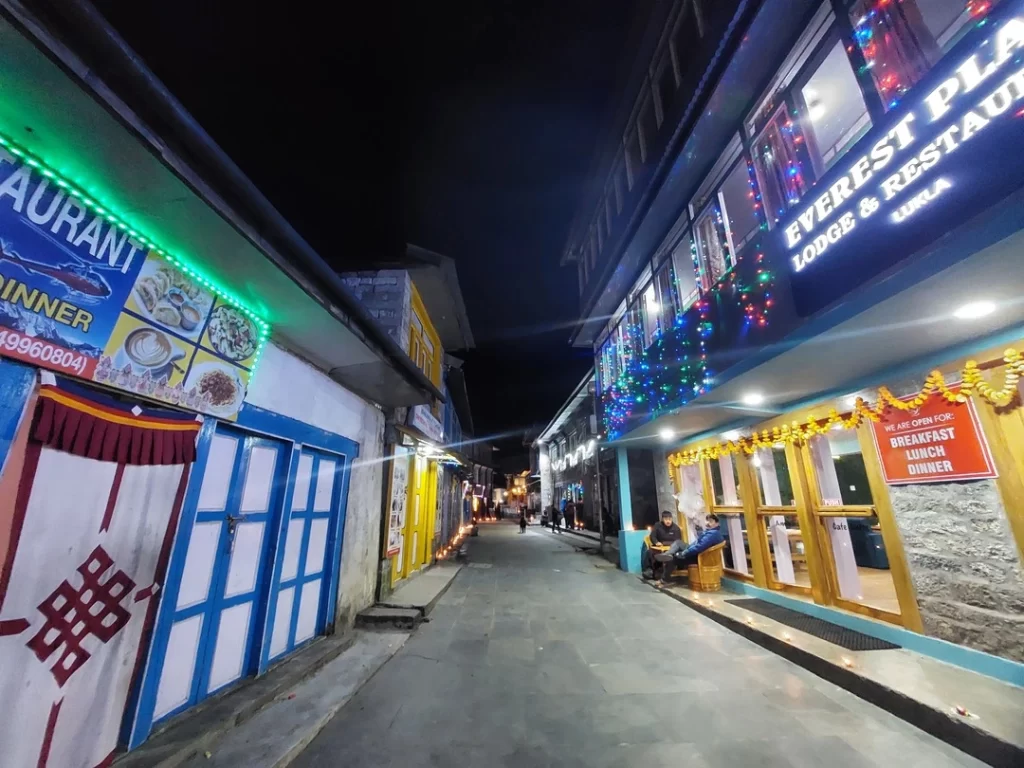
Phakding: First Night on the Trail
After leaving Lukla, trekkers make their way to Phakding (2,610 meters), which is generally the first overnight stop on the Everest Base Camp trek. The trek from Lukla to Phakding is relatively easy compared to later sections, taking about 3 to 4 hours to complete. This section of the trail is mostly downhill, offering a gentle introduction to trekking in the Himalayas.
Phakding is a quaint village nestled along the banks of the Dudh Koshi River. It features several teahouses and lodges that cater to trekkers, providing comfortable accommodation and hearty meals. Trekkers often use Phakding as a base to get into the trekking rhythm before tackling the more strenuous climbs ahead.
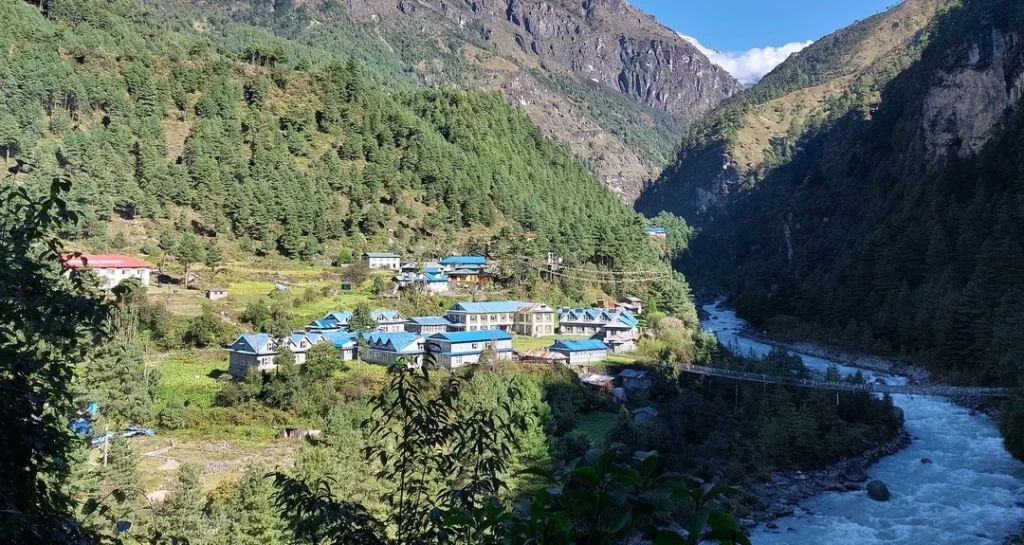
Namche Bazaar: The Sherpa Capital
Namche Bazaar (3,440 meters) is one of the most important stops along the EBC trek. This bustling town is known as the “Gateway to Everest” and serves as a central trading hub for the entire Khumbu region. Namche Bazaar is a natural amphitheater, set into the hillside with terraced buildings that house lodges, shops, cafes, and restaurants. The town is also home to several trekking gear shops where you can purchase or rent equipment in case you forgot something.
The two-day acclimatization stop in Namche Bazaar is essential for trekkers to adjust to the increasing altitude. During these rest days, trekkers are encouraged to take short hikes to higher altitudes and return to Namche to sleep. Popular day trips include hikes to the Everest View Hotel (3,880 meters), where panoramic views of Everest, Lhotse, and Ama Dablam can be enjoyed. Another option is to visit the Khunde and Khumjung villages, where you can experience more of the local Sherpa culture and see the Sir Edmund Hillary School.
Namche Bazaar also offers a cultural immersion with its Sherpa Museum, showcasing the history and culture of the Sherpa people, and its vibrant Saturday market, where traders from the nearby villages gather to sell their goods.
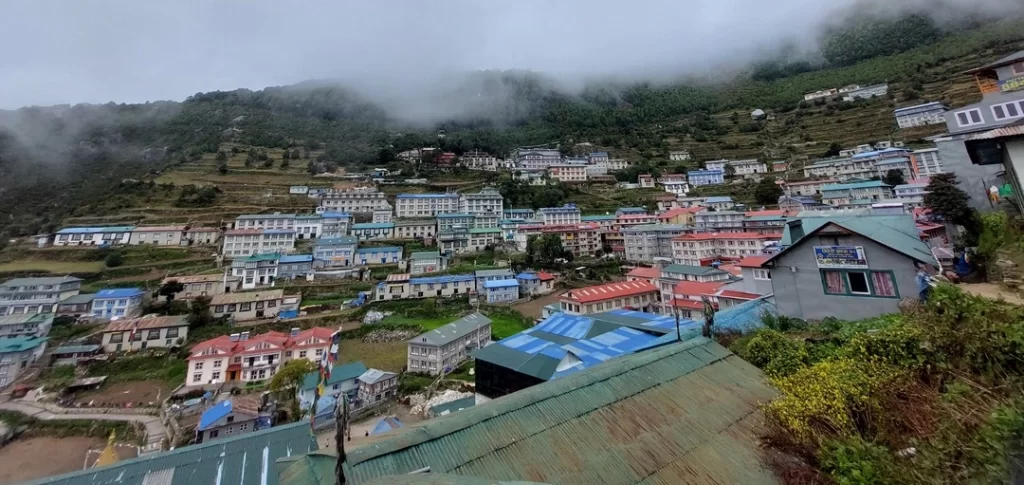
Tyangboche: Home of the Monastery
As trekkers leave Namche Bazaar, they make their way to Tyangboche (3,867 meters), a village known for its serene surroundings and its famous Tyangboche Monastery. The trail leading to Tyangboche offers some of the most stunning views of Mount Everest and Ama Dablam, but it also involves a steep climb that tests trekkers’ endurance.
Tyangboche Monastery is the largest monastery in the Khumbu region and a spiritual center for Sherpa Buddhists. Many trekkers stop here to participate in a prayer session or simply take in the tranquil atmosphere of the monastery, which sits against the backdrop of the Himalayan peaks. Tyangboche is a great place to spend the night, offering a peaceful retreat before the more physically demanding sections of the trek.
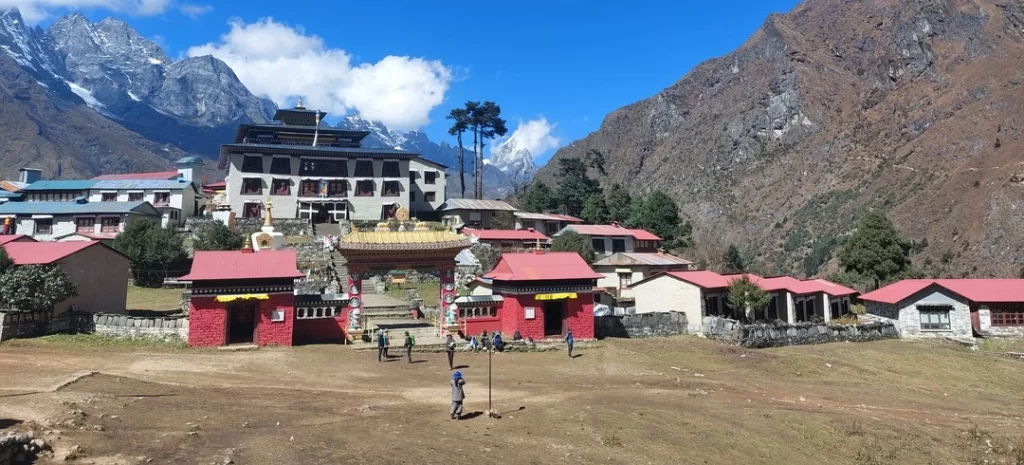
Dingboche: Acclimatization and Rest
Dingboche (4,410 meters) is another key stop for acclimatization. Situated in the Imja Valley, Dingboche is surrounded by towering peaks and offers breathtaking views of Ama Dablam. The village is larger and more spread out than the other settlements, with stone-walled fields dotting the landscape, and trekkers can choose from a variety of teahouses.
The acclimatization day in Dingboche is crucial as the altitude reaches new heights, and trekkers need time to adjust. Many trekkers opt to take short hikes to Nangkartshang Peak (5,083 meters), which offers spectacular views of Makalu, the world’s fifth-highest mountain, as well as other surrounding peaks. The hike also helps with acclimatization by following the “climb high, sleep low” principle, ensuring that the body adjusts more easily to the higher altitude.
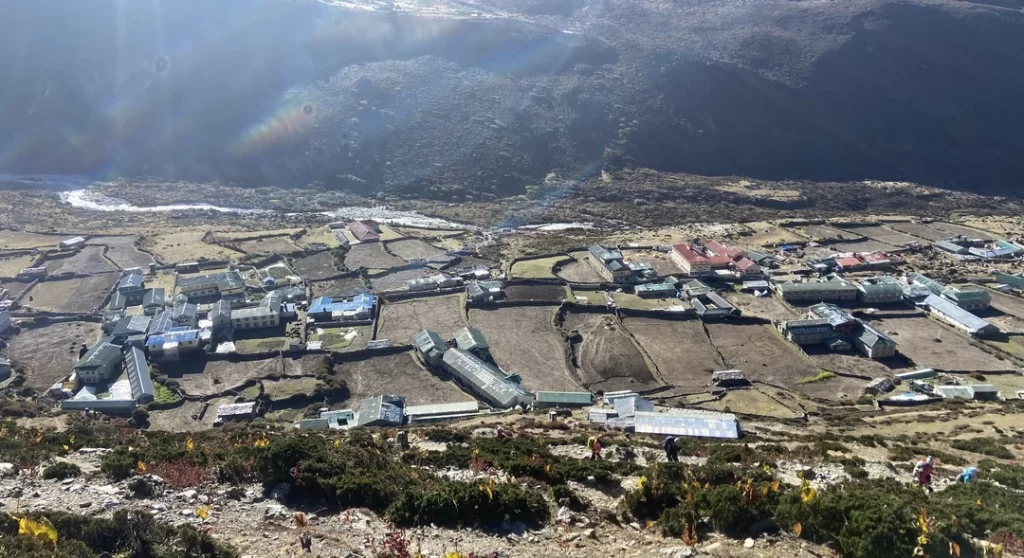
Lobuche: Approaching Base Camp
Lobuche (4,940 meters) is a small, high-altitude settlement that marks the final overnight stop before reaching Gorakshep and Everest Base Camp. The trek to Lobuche from Dingboche is challenging, with the air becoming noticeably thinner. As trekkers approach Thukla Pass, they encounter memorials dedicated to climbers who lost their lives on Mount Everest.
Lobuche is often described as a “resting place for the brave,” as trekkers must endure the discomfort of high altitude, cold temperatures, and basic accommodation. However, the stunning views of Nuptse and Lobuche Peak make the stop worthwhile. It’s essential to stay hydrated, eat well, and get plenty of rest here as the body works hard to adapt to the thin air.
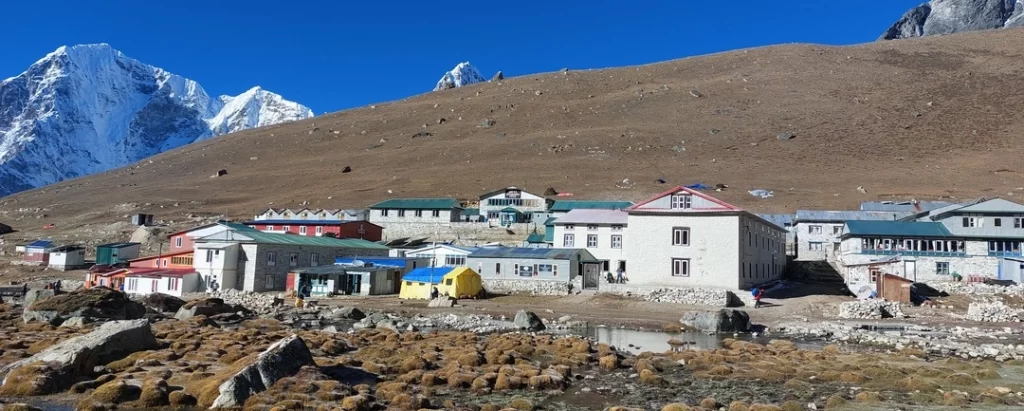
Gorakshep: The Last Stop
Gorakshep (5,164 meters) is the final stop before reaching Everest Base Camp. This remote outpost sits on a barren, glacial plateau surrounded by towering peaks. The trek from Lobuche to Gorakshep is short but challenging, with rocky and uneven terrain.
From Gorakshep, trekkers can make the final push to Everest Base Camp (5,364 meters), where they will be rewarded with views of the Khumbu Icefall and a sense of accomplishment like no other. Many trekkers also choose to climb Kala Patthar (5,545 meters) the following morning for a sunrise view of Mount Everest that is often hailed as the highlight of the trek.
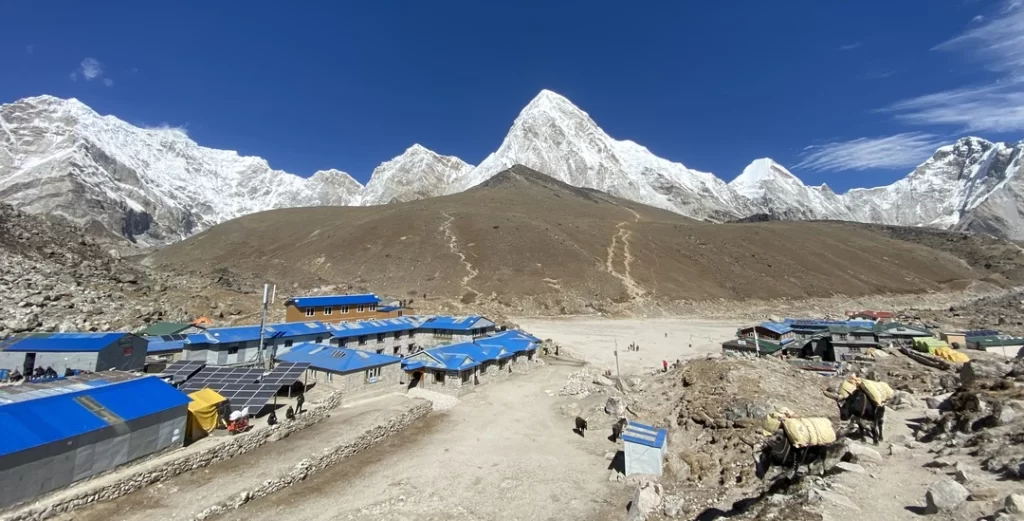
Pheriche: Beginning the Descent
After the excitement of reaching Everest Base Camp, trekkers begin their descent, with Pheriche (4,371 meters) serving as a common overnight stop. Pheriche is home to a medical clinic run by the Himalayan Rescue Association, which provides vital healthcare services to trekkers and climbers in the region.
The descent from Gorakshep to Pheriche is faster than the ascent, but trekkers must still be cautious and take their time. Pheriche is a peaceful village where you can rest, recover, and reflect on the incredible journey you’ve just completed.
Lunch Stops Along the Everest Base Camp Route
While overnight stops are crucial for rest and acclimatization, lunch stops along the trail provide trekkers with much-needed fuel for the journey. Here are the key lunch stops along the route:
Lukla to Phakding
Lunch stop: You can have lunch at Phakding itself, or if you want to break up the trek, you can stop at Thadokoshi along the way.
Phakding to Namche Bazaar
Lunch stop: The village of Jhorsalle is a convenient stop for lunch. This section of the trek involves crossing suspension bridges and navigating steep ascents, so a well-timed lunch break is essential.
Namche Bazaar to Tyangboche
Lunch stop: Phunki Thanga is the ideal spot for lunch. It’s located at the base of a steep hill leading to Tyangboche, so refueling here will give you the energy to tackle the final ascent.
Tyangboche to Dingboche
Lunch stop: Somare is the most common lunch stop on this stretch. After lunch, the trail continues with a steady uphill climb to Dingboche.
Dingboche to Lobuche
Lunch stop: You can stop at Thukla for lunch or push on to Lobuche if you’re feeling strong. This section involves a steep climb over the Thukla Pass.
Lobuche to Gorakshep
Lunch stop: Gorakshep itself is the lunch stop, as it’s the last settlement before Everest Base Camp. Trekkers often rest and refuel here before continuing on to Base Camp.
Gorakshep to Pheriche
Lunch stop: On the return journey, you can stop for lunch at Lobuche or Thukla, depending on your pace.
Pheriche to Namche Bazaar
Lunch stop: Phunki Thanga is once again a common lunch stop on the way back to Namche Bazaar.
Namche Bazaar to Lukla
Lunch stop: Phakding serves as a good lunch stop on the way back to Lukla, breaking up the long descent.
14 Days Outline Itinerary of the Everest Base Camp Trek
- Day 01: Arrival at Tribhuvan International Airport in Kathmandu (1400m/4,593ft)
- Day 02: Lukla flight from Kathmandu or Ramechhap and Trek to Phakding (2610m/8,563ft)
- Day 03: Trek to Namche Bazar (3440m/11,286ft) from Phakding
- Day 04: Acclimatization day at Namche Bazar | Hike to Syangboche and Everest Viewpoint
- Day 05: Trek to Tengboche (3867m/12,687ft) where the biggest Monastery is located
- Day 06: Trek to Dingboche (4410m/14,468ft) also known as the last settlement of Sherpa in the Khumbu Region
- Day 07: Acclimatization day at Dingboche and day excursion around the place | Hiking to Nangkartshang Peak
- Day 08: Trek to Lobuche (4910m/16,109ft)
- Day 09: Trek to Everest Base Camp (5364m/17,598ft) via Gorekshep and trek back to Gorekshep (5164m/16,942ft)
- Day 10: Hike to Kalapatthar (5545m/18,192ft) and trek back to Pheriche (4220m/13,845ft)
- Day 11: Trek back to Namche Bazar (3440m/11,286ft) from Pheriche
- Day 12: Trek to Lukla (2860m/9,384ft) from Namche Bazar
- Day 13: Fly back to Kathmandu (1400m) or Ramechhap (1,218m)
- Day 14: Departure from Kathmandu (1400m)
Conclusion
The Everest Base Camp trek is more than just a physical challenge – it’s an unforgettable journey through some of the most breathtaking landscapes on earth. Each stop along the everest base camp trek route offers its own unique charm, whether it’s the bustling streets of Namche Bazaar, the spiritual calm of Tyangboche Monastery, or the rugged beauty of Gorakshep. By understanding the key stops for overnight stays and lunch breaks, trekkers can better plan their adventure and ensure a safe, enjoyable, and successful trek to the foot of the world’s highest mountain.
FAQs
1. What is the best time to trek to Everest Base Camp?
The best times for the Everest Base Camp trek are pre-monsoon (March to May) and post-monsoon (September to November) when the weather is clear, and the trails are in good condition.
2. Do I need to book accommodation in advance?
While it’s not always necessary, booking accommodation in advance during the peak seasons (March-May and September-November) is recommended to secure a place in the more popular teahouses.
3. How long does the Everest Base Camp trek take?
The typical EBC trek takes between 12 and 14 days, including acclimatization days. However, the duration can vary depending on your pace and the number of rest days you include.
4. Is it possible to do the EBC trek solo?
Yes, many trekkers undertake the EBC trek solo. However, hiring a guide or joining a group can be beneficial, especially for navigation, acclimatization, and cultural insight.
5. What are the key tips for avoiding altitude sickness?
To avoid altitude sickness, it’s important to ascend slowly, stay hydrated, take acclimatization days, and listen to your body. Medication such as Diamox can also help, but should be taken under medical supervision.
